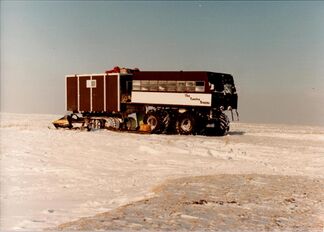Engineering:Tundra Buggy
A Tundra Buggy® is a custom built all-terrain vehicle used to view, photograph and study polar bears in the Churchill Wildlife Management Area of northeastern Manitoba, Canada. The term Tundra Buggy is a registered trademark of Frontiers North Adventures and only refers to one specific type of vehicle that is exclusively operated and found in Churchill, Manitoba.
History
The first Tundra Buggy was built in 1971 by Churchill resident Leonard D. Smith as a means to explore abandoned military trails east of the town of Churchill formerly used by the Churchill Rocket Research Range in the 1950s and 1960s and to travel to Cape Churchill in an area that would later become Wapusk National Park.
The first notable excursion of a Tundra Buggy, at the time called the Tundra Bus, occurred in 1979 when Smith took authors Richard C. Davids and Dan Guravich to Cape Churchill to photograph polar bears for their book Lords of the Arctic. [1]
Later that autumn Smith returned to Cape Churchill by Tundra Buggy with a National Geographic film crew and photographer. A subsequent article in National Geographic magazine along with a television programme "Polar Bear Alert" helped kick-start polar bear tourism in Churchill, putting the community on the map as the place to see and experience polar bears in their natural environment. The town of Churchill has since gained popularity and is known as the "Polar Bear Capital of the World".
It was this jump in polar bear tourism that prompted Smith to found a company he named "Tundra Buggy Tours". Smith went on to build 14 Tundra Buggies and the Tundra Buggy Lodge.[2] The Lodge consists of a diner, lounge, two bunkhouses, kitchen and utilities unit. It is towed from Churchill, Manitoba, behind the Tundra Buggy vehicles for several miles and connected together like units of a train on the west shore of Hudson Bay.
Leonard D. Smith received the Manitoba Tourism Innovation Award in 1989 and the Order of Manitoba in 2004.[1] In 2000 Smith sold Tundra Buggy Tours to Frontiers North Adventures.
Design and Production
Tundra Buggy inventor Leonard Smith was a mechanic with the Department of Public Works at Fort Churchill. To create the first Tundra Buggy, Smith converted an old school bus, combining it with parts of a gravel truck, a snowplow, a front-end loader and the tires from a crop sprayer.[2]
Tundra Buggies are built very high off the ground to ensure safety from polar bears, which can stand up to 3 meters tall. The tires on each Tundra Buggy vehicle are 5.5 feet (1.7 meters) high and 3.6 feet (1.1 meters) wide, and sit on 25-inch rims. A wide-bodied enclosure sits on top of the wheels and provides security, comfort and ability for passengers to move around to view and photograph wildlife. [3]
The Tundra Buggies are relatively self-sufficient with onboard air compressors, tool kits and extra fluids and oils. As well Tundra Buggies include comfortable seats, lavatories, windows that open and a large observation deck.
The engine in Tundra Buggies is an International DT 466, often found in highway semi-trailers. It is geared through an Allison Transmission and then geared through the differentials and planetaries on the hubs. The Buggies are full-time four-wheel drive and have the capability to lock the differentials if needed.
In 2015, Frontiers North began retrofitting the Tundra Buggy fleet to further reduce the environmental impact of the machines. The current Tundra Buggy uses a 235 horsepower engine. The heating system has also been altered from an electric block heater to German-made Webasto high efficiency diesel combustion coolant heaters, which allows for on demand interior forced air heating. The Tundra Buggy fleet uses environmentally friendly propylene glycol (i.e. engine coolant) and mineral oil lubricants, both whose Material Safety Data Sheets (MSDS) indicate no negative environmental impact.[3]
The top speed of a Tundra Buggy is approximately 45 km/h (28 mph) on a smooth trail, but usually travels much slower to allow for wildlife viewing and photography.
The Tundra Buggy fleet is now custom built and manufactured by Frontiers North Adventures. To date, 17 vehicles have been produced and are used by researchers[4] and tourists.
Current Operation
Frontiers North Adventures operates the Tundra Buggy during the summer and autumn months as a wildlife viewing vehicle for photographing and observing polar bears and other sub-Arctic wildlife outside of Churchill, Manitoba in the Churchill Wildlife Management Area. In the winter months the Tundra Buggy is used to cross the Churchill River for northern lights viewing.
References
- ↑ 1.0 1.1 North, Frontiers. "Dan's Diner: Then and Now" (in en). https://blog.frontiersnorth.com/dans-diner-culinary-adventure.
- ↑ 2.0 2.1 North, Frontiers. "Dan's Diner: Then and Now" (in en). https://blog.frontiersnorth.com/dans-diner-culinary-adventure.
- ↑ 3.0 3.1 "Tundra Buggy Frequently Asked Questions" (in en). 2017-04-26. https://frontiersnorth.com/tundra-buggy-faq.
- ↑ North, Frontiers. "Partnering to Protect Polar Bears" (in en). https://blog.frontiersnorth.com/partnering-protect-polar-bears.






